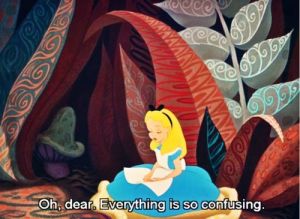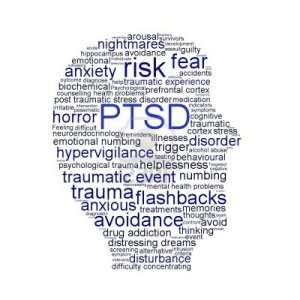I tried hard to be a voice of reason to my daughter. But how does one reason where there is no willingness to receive it? It didn’t work for Alice after she fell down the rabbit’s hole, and it wasn’t working for me. Still, it seemed all I could do.

(Source)
Tuesday night had seen a change to my daughter’s medication. The two SSRI anti-depressants she’d tried in the previous weeks had served only to take her deeper into rage, depression, and thoughts of suicide.
She was switched to a medication initially developed to treat seizures but used off-label to treat mood disorders. As those with mental health issues often find, medication is not an exact science. Not at all. But the aim at this point was to stabilize her, which (ironically) meant taking her off anti-depressants.
She soon found out that the term “72 hour hold” was a misnomer, more a guideline than a declaration. This was first a rumor she heard from other adolescents in the unit, and then she found out it was to be her reality.
I tried to explain the reasoning behind the need for her to stay in the psych ward longer. “They’ve switched your meds. The old ones obviously didn’t work well for you. They need to make sure you don’t have a bad reaction to this new medication. It’s a safety issue.”
Predictably, she was not receptive. For the record, I’m not so sure I would have been either if I’d been in her shoes. Also predictably, her anger flared. She was not allowed contact with any friends while she was hospitalized, and even if the support system she’d built for herself was terribly dysfunctional and harmful, all she knew was that it had been taken from her. And she was mad.
There were some curious things I realized about myself in those few days, difficult things that made me sad and confused.

(Source)
I knew that I was afraid for my daughter to be released from the psych ward and sent home. I was fearful that she would quickly return to her previous behaviors and that I was just too worn down to be an effective parent anymore. I was scared that there would be no lasting changes resulting from this awful ordeal. And I was so out of ideas.
I knew that my goal was not to keep my daughter from getting angry nor was it to have her like me. My goal was to keep her safe, even if she came to hate me in the process.
I knew that I wanted to put up all kinds of roadblocks so that her choices were limited and she couldn’t make decisions that would be harmful. But I knew that would be a disservice to her, that it would mistakenly teach her that she could not be responsible for herself.
I knew that, in the bigger picture, I couldn’t and really didn’t want to control my daughter; I wanted her to learn to control herself.
I knew that for that to happen there had to be boundaries and consequences in place, and that she had to choose her actions and thus her own outcomes. This was a source of great pain for me, because I knew some of the choices she would make and that their results would be very hard for all of us.
But I had to let that go. Even though I could see that she was not yet willing (or able?) to face some of her bigger issues, I had to let her choose for herself.
I will once more refer to an email I wrote to my small and trusted circle of support. This was yet another middle of the night message, a bit disjointed and bearing witness to my fears and frustrations. This was written on day three of my daughter’s stay at the behavioral center, the day she had mistakenly decided she was going to be released and sent home.
* * *
I had a meeting today with C and her dad and caseworker. There was a chance for C to have her say and a chance for us to, then time for us parents to meet alone with the caseworker. We were told early in the meeting that C would not be released until Saturday (day five of her “72 hour” hold). We really lost her at that point. She wants to come home NOW.
She was not forthcoming about some stuff she’s been lying about lately, nor about what might have been bothering her that led up her hospitalization. She’s been telling me for weeks about some things that are just driving her crazy, but she never even mentioned them in today’s meeting. I told her that I’d learned about some of her deceptions but she would not acknowledge anything, just said she had no idea what I was talking about.
I tried to prepare her for the fact that things will be very different when she gets back home, that boundaries will be tighter, and privileges will need to be earned back. I don’t think she has any idea what that means or thinks it will really happen anyway.
I am feeling extremely overwhelmed at the thought of her return home. The caseworker had all kinds of thoughts and ideas, and while some of them may be helpful, the work of it all feels like it will bury me.
When her dad and I walked out of our meeting with the caseworker, C came straight over and asked me why she couldn’t be released sooner. She was very angry and confrontational and kept demanding answers that I couldn’t give her. I gave her the only answer there was to give, but she wanted more and I told her that was all I had, I couldn’t make anything up to satisfy her.
She directed all her anger and frustration towards me. I don’t think she even made eye contact with her dad for that 5 to 10 minute conversation. She made vague threats about not eating (that’s her choice if she wants to make it) and swore she was better and ready to come home. It was really pretty awful.
She chose me to be the one to pick her up when she is released on Saturday. She told me she wants me there at 6 in the morning. I told her I’d be there between 9 and 10.
I know there are many strategies to deal with her in the days ahead; I just honestly feel like there is nothing left in me to do it – to learn what I need to learn as a parent, to find her a new psychologist (her request and the caseworker’s recommendation), to drive her across town how many times a week for those appointments, to find extra-curricular activities & get her enrolled & to the activities, to meet with her school counselor and teachers and try to help her not fail her freshman year.
I am just spent, which may be exactly where I need to be but it doesn’t make any sense to me and I can’t see how it’s all supposed to get done.
I did tell her dad that with these added commitments I cannot logistically do all that needs to be done for both girls during the week (always on ongoing battle for me), and he said he’d be available but the truth is that he works during the hours these things are going on. I will have to continue to change and arrange my work schedule to take care of things.
I don’t expect him to make any sizable contribution to handling those details because he hasn’t before. It would be helpful if he actually had some input or action of his own; I feel like it’s up to me to take the lead on these things because he simply will not and we are at a critical juncture where action must be taken. He does not seem to accept the seriousness of the situation. (Caution: ex-wife frustrations are surfacing!)
Again, the ideas for help and change sound really good in theory but the reality of it feels nearly impossible to me. There just isn’t enough of me to go around.
The diagnosis the caseworker gave for C today was General Anxiety Disorder and Depressive Disorder. I don’t know if a new therapist will reach a separate conclusion. C says she hasn’t been suicidal for about a day and a half. She says cutting is stupid and disgusting and she’ll never do it again (which she’s said before), and she swears that she has learned all she needs to know and will be fine.
She also says she wants to “help” her friends who cut to stop cutting, which basically translates to her taking responsibility for their actions – which scares me especially when she cannot take responsibility for her own.
After today, I cannot imagine a conversation with her that is not angry and confrontational and manipulative.
I do get that her choices are her own and that my job, after assuring her safety, is to allow her to deal with the consequences of her choices. I know very well what some of those consequences could end up being, and I can honestly say I hate that.
Maybe that is where so much of my anxiety is coming from and I need to work towards what is acceptable and adequate, not what is perfect and guaranteed (those two options really don’t even exist). But I selfishly look at those consequences, should they come – and I know some of them will – and I know that they will result in even more being put on my plate and I feel frustrated and angry about that.
Well so there it all is. I am too tired to make this (or me) sound nice. I have no neat or tidy wrap up for this message; I’m just continuing to ask for and appreciate your prayers and hoping that my ranting and venting haven’t been too offensive.
In a few hours I start a very busy day, not only working on my taxes, etc., but also working out C’s discharge, contacting her school, trying to track down and interview therapists and stuff like that. I appreciate your prayers and support.
© Monica Simpson and Help To Hope, 2013
https://www.facebook.com/HelpToHope
https://twitter.com/HelpToHope




















